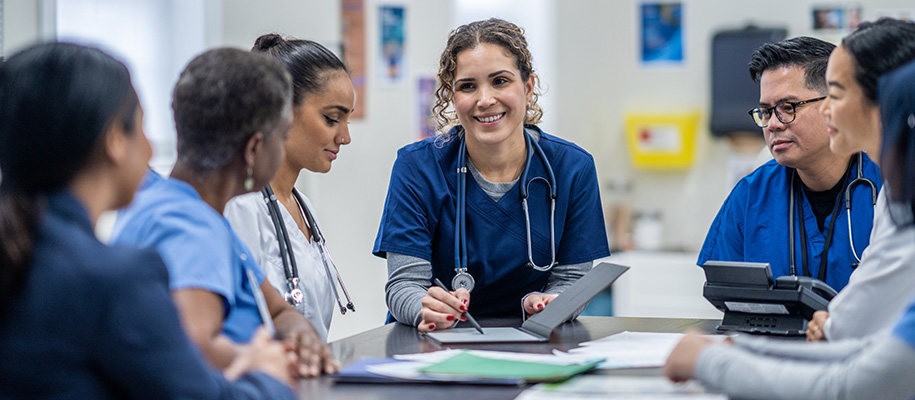From physician assistants to radiologists to dietitians, there are so many career options in medicine beyond the doctors and nurses you’re accustomed to seeing on television and during your yearly checkups. Whichever position you pursue, you’ll be working on a team with these other medical professionals at some point in your future career. A team mentality is crucial for health care providers to give the best possible care for their patients. Let’s look at what team-based care is all about using a fictitious example based on real-world facts.
What is team-based care?
Team-based care refers to a group of health care providers working together to administer the appropriate treatment to a patient. This has become the standard model for health care as professionals share their complementary skills and knowledge. If you’re considering a career in medicine but aren’t sure where to start, it can help to take a look at the many different types of health care providers out there and how each of their roles plays into the overall care of patients. Here’s an overview of those providers and their responsibilities through the following scenario. (Though a fictional story, this is quite representative of how a team of medical professionals works together to ensure patients receive the best care possible!)
Related: Career Spotlight: The Ultimate Guide to Unique Health and Medicine Careers
The inciting incident
One night, Lauren was driving home on snow-covered roads when she noticed a small vehicle spinning toward her large SUV. She had a choice: swerve off the street and hit a huge pine tree or stay on the road. She chose the road and a few seconds later, the spinning car plowed into Lauren’s vehicle. Someone in a neighboring house heard the crash and called the police, who were on the scene within minutes. When the ambulance arrived, Lauren was adamant about not going to the emergency room because her leg “wasn’t hurting that much.” After a few minutes, the paramedics convinced her to go to the hospital.
The paramedics
Paramedics serve on ambulance crews and, in the case of accidents, can be the first medical provider to the patient. According to the University of California, Los Angeles’s Center for Prehospital Care, paramedics with backgrounds as emergency medical technicians (EMTs) have skills that include “administering medications, starting intravenous lines, providing advanced airway management for patients, and learning to resuscitate and support patients with significant problems such as heart attacks and traumas.”
Arriving at the hospital
The paramedics safely transported Lauren to the local hospital’s emergency room (ER), where she was greeted by a friendly emergency room nurse and wheeled into a patient room. As the ER nurse assessed Lauren, the emergency room physician made a quick visit to her room. After he finished interviewing her and conducting a physical exam, the doctor ordered an X-ray of Lauren’s shin and ankle.
The emergency room nurse and physician
Nurses are usually the ones that have to be the most adaptable, as they may be the first hospital contact with a patient and have to be ready to give care within moments of arrival. “In a typical day (if there is such a thing!) the emergency nurse may well treat patients with everything from severe respiratory distress to chest pain, overdose incidences, seizures, pulmonary edema, and countless other scenarios,” says Anne Manton in her article “Emergency Nursing.” On the other hand, the emergency room physician quickly follows suit to come up with a proper plan of care for the patient. According to the Department of Emergency Medicine at the University of California, Irvine’s School of Medicine, “The emergency physician’s role is to assess, treat, admit, or discharge any patient that seeks medical attention at any time of day or night.”
Related: Make a Difference by Majoring in Nursing
Running tests
Lauren was wheeled out of the room and into the X-ray room. There she met the radiologic technologist who performed the X-ray on her. Once the radiologic technologist finished, she told Lauren she would take her back to her room and the radiologist would review the X-ray, report the results, and discuss them with the emergency room physician.
The radiologic technologist and radiologist
Radiologic technologists “are the medical personnel who perform diagnostic imaging examinations and administer radiation therapy treatments,” says the American Registry of Radiological Technologists. These health care professionals work with radiologists, who the American College of Radiology describe as “medical doctors (MDs) or doctors of osteopathic medicine (DOs) who specialize in diagnosing and treating diseases and injuries using medical imaging techniques,” from X-rays and MRIs to ultrasound.
The diagnosis
Soon after, the ER physician visited Lauren to inform her that her ankle had sustained a fracture and she needed to have it casted in the orthopedic division. Once in that area of the hospital, Lauren met with the physician assistant (PA). The PA reviewed her X-ray and escorted Lauren to the casting room. As she waited for the PA to return with the orthopedic physician, Lauren noticed the array of casting tables, supplies, and instruments the physician assistant had prepped for the physician. Lauren’s doctor showed her the fracture on the X-ray, explained the casting process, and even let her pick out the color of her cast.
The physician assistant and orthopedic physician
Physician assistants “perform physical exams, diagnose illnesses, develop and carry out treatment plans, order and interpret lab tests, assist in surgery, provide patient education, and in most states, prescribe medications,” according to The King’s College PA program website. PAs are incredibly well-rounded medical professionals who help the team by being adaptable to needs, whereas orthopedics “focuses on injuries and diseases of your body’s musculoskeletal system,” according to the American Academy of Orthopedic Surgeons. “This complex system includes your bones, joints, ligaments, tendons, muscles, and nerves and allows you to move, work, and be active.” Often health care requires adaptability as well as the expertise and specificity of an orthopedic surgeon.
Related: The Fast Track to Medicine: 6-Year Direct-Entry Medical Programs
Follow-up care
Lauren returned home from the ER and started experiencing some soreness in her neck. The next day, she scheduled an appointment with her family physician to discuss the accident and her pain. Lauren was checked in and escorted to her room. The nurse asked if it was okay to allow a third-year medical student to observe the appointment, and Lauren agreed. Lauren explained the accident and her symptoms to the med student and her family physician, who reviewed the negative X-ray and ordered an MRI of her head and neck.
The family physician and medical student
Your regular physician is a cornerstone in your life starting from a young age. Although outside of a hospital care team, family or primary care physicians provide important follow-up care after an injury as well as general health checkups. Students in their third year of medical school participate in clinical experiences in each of the six core disciplines of medical education: surgery, medicine, psychiatry, pediatrics, family medicine, and OB/GYN. As part of their medical education, students get to see patients during their studies so they can learn from them and the other members of the health care team.
Related: 5 Ways to Prepare for Medical School Right Now
Getting another procedure
As she entered the MRI facility, Lauren met the medical assistant, who checked her in for her MRI. The medical assistant notified the Magnetic Resonance Imaging (MRI) technologist that Lauren was ready for her. As Lauren lay down patiently while the MRI was being completed, she tried not to move as the MRI technologist requested. Once the scan was completed, the MRI technologist informed Lauren that the radiologist would evaluate the MRI, write a report, and send the information to her family physician. Lauren was satisfied and left the appointment with hopes that she would soon have an answer to her neck pain.
The medical assistant and MRI technologist
Medical assistants “work alongside physicians, mainly in outpatient or ambulatory care facilities, such as medical offices and clinics,” according to the American Association of Medical Assistants. They provide an extra level of comfort and ease to patient care to keep everything running smoothly. With that, “MRI technologists perform scans using radio frequencies within a magnetic field to produce images of bones, organs, and soft tissue,” says the American Registry of Radiologic Technologists. MRI technologists have another very specific skill set in knowing how to work these complex scientific machines.
Extended care and the healing process
The MRI revealed Lauren had sustained a muscle strain, better known as whiplash. Therefore, her family physician suggested she see a chiropractor. During the office visit, the chiropractor informed her that there were issues with the cervical vertebrae of her spine. Her chiropractor advised Lauren to continue with biweekly appointments and not to lift anything over five pounds.
As Lauren continued her treatment plan, it was soon time to return to the orthopedic physician’s office for her cast removal. Once the cast was removed, Lauren was taken for additional X-rays of her ankle and given the fantastic news that it had healed. Because her ankle was in a cast for six weeks and her muscles had weakened, the orthopedic surgeon suggested she see a physical therapist to regain the flexibility and strength in her ankle she had prior to the accident. Lauren was thrilled that her recovery from the accident was almost complete and that she would soon be able to return to her normal activities.
The chiropractor and physical therapist
Chiropractors provide health care to patients who often suffer from chronic pains and see their patients regularly. “Doctors of Chiropractic perform patient management and conduct diagnoses, giving special emphasis to neuromusculoskeletal conditions,” according to the New York Chiropractic College. While a chiropractor helps realign your neuromusculoskeletal conditions and give you immediate relief, physical therapists aim to teach you methods of exercising that you can facilitate on your own for continued strengthening, healing, and easing of pain.
Related: How Can I Properly Evaluate the Quality of a Health and Medicine Program?
Choosing your med school path
People often think that if you’re going into the medical field, you’re either a nurse or a doctor, but so many more roles and responsibilities go into giving the general public the best possible care. There are even more health care roles not mentioned in this example scenario, like pharmacists providing essential medications. The medical world is a vast and rewarding place, so really explore all the possibilities if you’re considering this field—all the opportunities may surprise you!
Start searching for the right medical school and program for your goals today using our College Search tool.
References:- American Academy of Orthopaedic Surgeons. (2007). Orthopaedics.
- American Association of Medical Assistants. (2014). What Is a Medical Assistant?
- American College of Radiology. (n.d.) What Is a Radiologist?
- American Registry of Radiologic Technologists. (2014). Magnetic Resonance Imaging (MRI).
- Department of Emergency Medicine at the University of California, Irvine School of Medicine. (2014). Physician’s Role.
- King’s College. (n.d.). Physician Assistant.
- Manton, A. (2004). Emergency Nursing.
- New York Chiropractic College. (2014). Doctor of Chiropractic.
- UCLA Center for Prehospital Care. (n.d.). What’s the Difference Between an EMT and a Paramedic?





